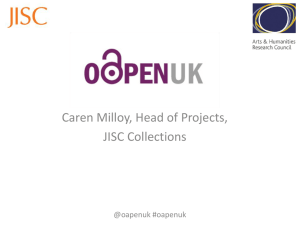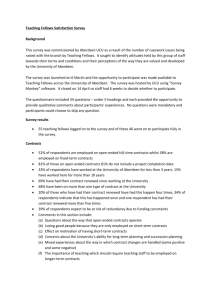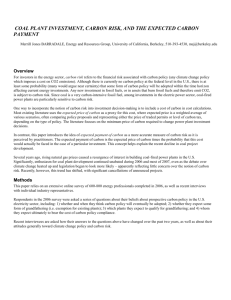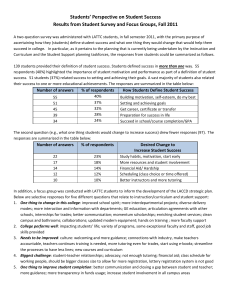Read the full report - Ministry of Youth Development
advertisement
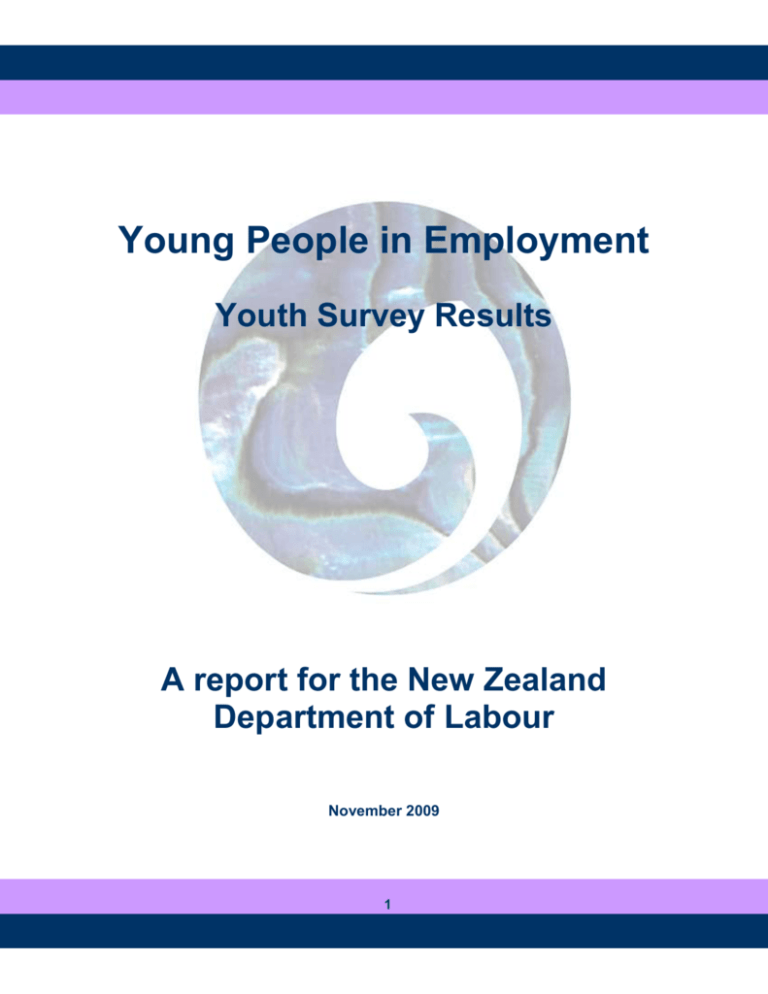
Young People in Employment Youth Survey Results A report for the New Zealand Department of Labour November 2009 1 TABLE OF CONTENTS About this report ................................................................. 3 Background ......................................................................... 3 Project brief ............................................................................................ 3 Methodology ........................................................................................... 3 Responses ........................................................................... 4 Limitations .............................................................................................. 4 Survey questions ................................................................................... 5 Question One.......................................................................................... 5 Question Two ......................................................................................... 5 Question Three ....................................................................................... 6 Question Four......................................................................................... 6 Question Five ......................................................................................... 6 Question Six ........................................................................................... 8 Conclusion ........................................................................... 9 Appendix One: Default Survey Questions ...................... 10 Demographic and employment activity data ..................................... 10 2 About this report This report summarises the submissions received from young people in response to the youth employment survey, jointly led by the Ministry of Youth Development and the Department of Labour. Background Project brief The Department of Labour is leading a project to promote good practice and policies for young people’s work in Asia-Pacific Economic Cooperation (APEC) economies. As part of this work, the project is seeking to identify what good practice and policies for young people’s work looks like in the APEC economies that are taking part in the project1. One of the means by which the project is sourcing this information is through a survey of policy-makers’ understanding of how society views the employment of young people (defined as under-25 years) in their economies. To strengthen the New Zealand dataset, the Ministry of Youth Development offered to elicit the views of young people in New Zealand on the same topic through a separate survey specifically for young people. This report summarises the responses received through the youth survey. Methodology The Department of Labour contracted Research New Zealand to develop a survey questionnaire for policy makers in the APEC economies participating in the project. The Ministry of Youth Development and the Department of Labour then identified the questions from this wider survey that were deemed to be most relevant to young people, and developed these into a specific survey for young people. The Ministry used SurveyMonkey, a computer programme to produce the survey electronically. This allowed participants to make an online submission and enabled a database of submissions to be created for analysis. The Department of Labour requested low key promotion of the survey for the period 6-18 November 2009 on the Ministry’s website www.myd.govt.nz. The survey was promoted by the Ministry’s regional teams to young people they thought may be interested, and electronically to the Ministry’s Aotearoa Youth Voices network of 1800 young people. 1 Brunei, Singapore and Chile, Thailand, Canada, the Philippines, the United States, Peru, Indonesia, Australia, Malaysia, and Chinese Taipei (Taiwan). 3 Responses In total, 109 responses were received. All responses were from young people aged between 12 and 24 years, and all have been analysed and are reported here. Limitations The findings of this survey do not denote the views of the total youth population of New Zealand, but rather provide a snapshot of some youth views and opinions on the topic of youth employment. Furthermore, the nature of some of the questions was such that it required the young people responding to interpret the question in their own way, for instance “what importance/value does society place on young people completing a formal education?” This type of question requires respondents to interpret what they themselves perceive to be formal education, and how they personally perceive society values this. Given the subjective nature of this type of question, it is not possible to guarantee that all young people that responded interpreted the question in the same manner, for instance some young people may have interpreted formal education to mean high school, whereas others may have interpreted this to include tertiary study. In addition, given the diversity of experiences among young people, the corresponding values that the respondents aligned to their interpretation, are likely to differ. The value of this report is that it outlines responses in relation to those participating young people’s own views and values on the topic of youth employment. The survey allowed for, but did not require responses to every question. The intention being to enable young people to respond if they had an opinion in relation to a specific question, rather than requiring them to devise an opinion in all cases. As a result, the response rates vary across questions in the survey; the percentages reported therefore relate, in each question, to the total number of respondents for that question rather than the total number of respondents to the survey. 4 Survey questions Question One When asked “what importance/value does society place on young people completing a formal education?” a majority of respondents (60%) felt that “quite a lot” of importance is placed on completing a formal education. Table 1. below refers: Table 1. What importance/value does society place on young people completing a formal education? Count % None 0 0.0% Not much 3 3.1% Some 24 25.0% Quite a lot 58 60.4% A lot 11 11.5% Total 96 100% Question Two When asked “what importance/value does society place on young people under 19years of age doing work for pay?” responses were mixed; however, a majority of the respondents either felt “some” importance is placed on this (44%) or “quite a lot” of importance is placed on this (29%). Table 2. below refers: Table 2. What importance/value does society place on young people under 19 years of age doing work for pay? Count % None 3 3.1% Not much 19 19.6% Some 43 44.3% Quite a lot 28 28.9% A lot 4 4.1% Total 97 100% 5 Question Three When asked “under what circumstances do people in your society think children under15 years of age should be employed in paid work?” the most common thematic responses were: if the young person wants to and/or feels they need to for pocket money (28%) as long as the work is fair and reasonable for the young person’s age/ability eg paper deliveries, babysitting (16%) to pay for their own things, particularly if the family is struggling financially (11%). Only 8% of respondents felt that children and young people under 15 years should not be employed in paid work. Question Four However, when asked “under what circumstances do people in your society think children under-12 years of age should be employed in paid work” the responses were markedly different. In relation to this question, the largest proportion of respondents (44%) did not think that children of this age should be employed in paid work. Where respondents indicated this may be okay, the response was typically qualified by the type of work that the child was engaged in. For instance, 30% of respondents identified they thought children under-12 years could be in paid employment, but only if the work was fair and reasonable for the child’s ability. Mostly this was qualified as being work such as household chores, lawn mowing or paper deliveries, where parents could supervise and/or assist the child in the work if necessary. Question Five Further, when asked “what is considered an appropriate balance between time spent in education and time spent in employment (for children and young people who are in both education and paid employment)?” most respondents choosing to answer this question indicated that education should be a full-time priority for children and young people and that if undertaken, employment should instead be part-time or casual. Table 3. on the following page specifically refers: 6 Table 3. What is considered an appropriate balance between time spent in education and time spent in employment (for children and young people who are in both education and paid employment)? full time (6-8 hours per day) part time (less than 6-8 hours per day) casual (when ever they want) Count Education 77 16 3 96 Employment 6 50 37 93 Chart 1. below further illustrates the balance that respondents identified as appropriate for children and young people who are both in education and undertaking paid employment: Chart 1. What is considered an appropriate balance between time spent in education and time spent in employment (for children and young people who are in both education and paid employment)? 120 100 full time (6-8 hours per day) 80 60 part time (less than 6-8 hours per day) 40 casual (when ever they want) 20 0 Education Employment 7 Question Six The final question of the survey asked respondents “what issues are affecting the ability of children and young people to work?” The most common responses to this question included: school work/extra-curricular activities (21%) parental/family attitudes and/or responsibilities/obligations at home (14%) availability of work (impacted by the current recession) (12%) lack of skills/qualifications/work experience (11%) employer attitudes and reluctance to employ young people over [more qualified/highly skilled] adults (10%). 8 Conclusion The survey findings indicate that paid employment for young people in New Zealand is broadly seen, by the young people who participated in the survey, as an acceptable activity. This is provided that the work is both fair and reasonable for the young person’s age and ability, and so long as the work does not interfere with the young person’s education, which was generally identified throughout the survey findings as a being of greater priority to undertaking employment. While some respondents indicated that it may be okay for children under-12 years to be in paid employment, for the most part, the findings indicate there is a greater acceptance of, and support for young people to undertake employment as they mature. The responses indicate there are a number of activities and responsibilities that may impact on a young person’s desire and ability to undertake paid employment. These are likely to differ for each young person, although school work and extra curricular activities were most commonly identified by the young people as a reason to either limit or postpone their entering into paid employment. The Ministry of Youth Development would like to thank all the young people who took part in the youth employment survey, for sharing their views. 9 Appendix One: Default Survey Questions Demographic and employment activity data While the survey respondents were spread across the ages of 12-24 years, most of the young people (57%) were aged between 16 and 18 years. Table 4. below sets out all responses to this question. Table 4. Age (years) Count % 12 1 0.9% 13 1 0.9% 14 3 2.8% 15 7 6.4% 16 16 14.7% 17 21 19.3% 18 25 22.9% 19 12 11.0% 20 6 5.5% 21 2 1.8% 22 6 5.5% 23 1 0.9% 24 Total 8 7.3% 109 100% The majority of respondents (68%) identified themselves as being of Pakeha/NZ European ethnicity. Please note, however, that the survey enabled multiple responses to this question, as some people identify with more than one ethnicity. As a result, the ethnicity percentage total exceeds 100%. Table 5. on the following page sets out all responses to this question. 10 Table 5. Ethnicity Count % Pakeha/NZ European 74 67.9% Maori 24 22.0% Pacific 9 8.3% Chinese 5 4.6% Indian 4 3.7% Other 11 10.1% Most of the young people that responded to the survey identified that they were currently attending school and were employed (64%). Table 6. below refers: Table 6. Activity Count % Employed, but ALSO attending school or other educational / training institution 70 64.2% Employed, and NOT attending school or other educational / training institution 15 13.8% NOT employed or attending school or other educational/training institution 24 22.0% Total 109 100% Of the young people that indicated they were employed, the most common occupation was service workers and shop and market sales workers (35%). Table 7. below refers: Table 7. Occupation Count % Professionals 5 4.6% Technicians and associate professionals 1 0.9% Clerks (office) 4 3.7% Service workers and shop and market sales workers 38 34.9% Craft and related trades workers 2 1.8% Elementary occupations 3 2.8% Armed forces Other Total 11 2 1.8% 54 109 49.5% 100% However, 50% of the respondents selected “other” from the range of options. Within this 50% some young people selected multiple categories of occupation. The most commonly identified were: not in paid employment (30%) retail/customer service (10%) hospitality roles (7%). Table 8. below sets out all responses to this question: Table 8. Occupation Count % Newspaper delivery 1 1.7% Healthcare-related 3 5.0% Hospitality 4 6.7% n/a 18 30.0% Childcare 3 5.0% Librarian 3 5.0% Cleaner 3 5.0% Drama 1 1.7% Tutoring 3 5.0% Local Government 2 3.3% Horticulture 1 1.7% Security 1 1.7% Retail/customer service 6 10.0% Social work/youth work 3 5.0% Support worker 1 1.7% Recreation-related 2 3.3% Home jobs 1 1.7% Research-related 1 1.7% Manual labour 1 1.7% Media-related 1 1.7% Barrister 1 1.7% Total 60 100% 12 Most of the young people that responded to the survey (63%) were located in one of New Zealand’s four main centres; Auckland (29%), Wellington (18%), Christchurch (9%) or Dunedin (6%). Table 9. below sets out all responses to this question. Table 9. Location Count % Auckland 32 29.4% Buller 1 0.9% Christchurch 10 9.2% Coromandel 1 0.9% Dunedin 7 6.4% Greymouth 1 0.9% Hamilton 2 1.8% Hawkes bay 5 4.6% Horowhenua 2 1.8% Kaikoura 1 0.9% Kaitaia 1 0.9% Masterton 1 0.9% Nelson 3 2.8% Taranaki 3 2.8% Palmerston North 8 7.3% Rotorua 2 1.8% Ruatoria 1 0.9% South Canterbury 1 0.9% Tauranga 2 1.8% Wanganui 2 1.8% Wellington 20 18.3% Whangarei 1 0.9% Unknown Total 13 2 1.8% 109 100%





